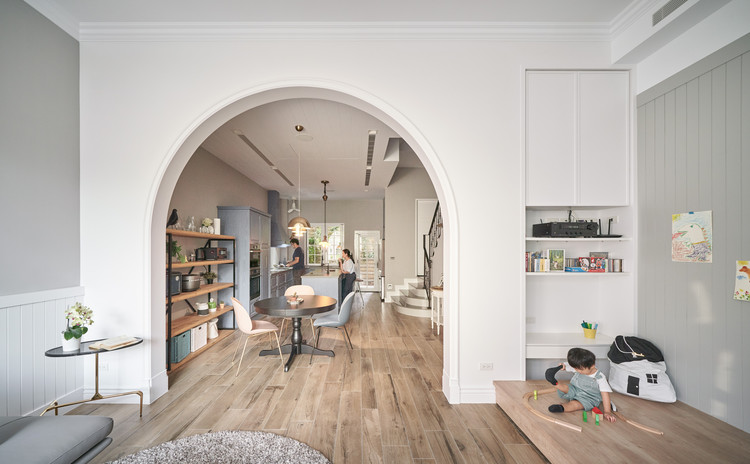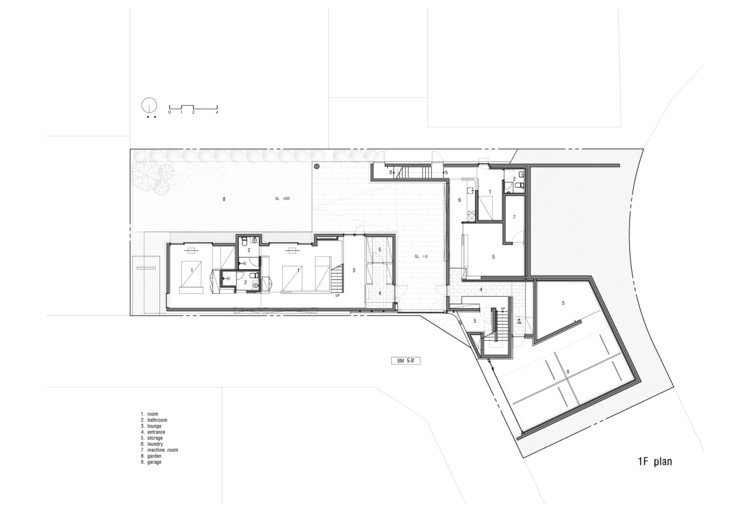Vol Walker Hall - the Steven L Anderson Design Center Marlon Blackwell Architect
2013-12-11 00:00
室内设计的记录马龙布莱克威尔建筑师-梅丽亚蒂乔哈里布莱克韦尔,阿索克。AIA室内设计总监室内设计助理波尔克斯坦利威尔科克斯建筑师-金伯利普雷斯科特ASID内饰主任。总承包商鲍德温
Interior Design of Record Marlon Blackwell Architect - Meryati Johari Blackwell, Assoc. AIA, ASID Director of Interiors Interior Design Associate Polk Stanley Wilcox Architects - Kimberly Prescott ASID Director of Interiors. General contractor Baldwin & Shell Construction Company Structural Engineer Kenneth Jones & Associates, Inc. Mechanical, Electrical, Plumbing, Fire Protection Engineer TME, Inc. Civil Engineer Development Consultants, Inc Landscape Architect Crafton Tull Sparks Lighting Designer Renfro Design Group Geotechnical Consultant Grubbs Hoskyn Barton & Wyatt, Inc Preservation Consultant John Milner Associates, Inc. Concrete Consultant Clarkson Consulting, Inc. Acoustics and Daylighting Consultant Dr. Tahar Messadi LEED Project Team Marlon Blackwell Architect and Polk Stanley Wilcox Architects. Curtain Wall Consultant Heitmann & Associates, Inc. Accessibility Consultant LCM Architects Construction Document Coordination Review Consultants RediCheck North. LLC. Owner University of Arkansas Cost $32,427,555 Manufacturers Loading... More Specs Less Specs
架构师提供的文本描述。史蒂文·L·安德森设计中心(Steven L.Anderson Design Center)是沃克尔大厅(VolWalker Hall)的3.7万平方英尺(约合1.7万平方米),由马龙·布莱克韦尔(Marlon Blackwell)建筑师和波尔克·斯坦利·威尔科克斯(Polk Stanley Wilcox)建筑师合作设计。该中心旨在成为对VolWalker大厅传统建筑的现代补充,既对过去敏感,又不模仿它,旨在增强历史校园规划为了实现这些设计目标,在计划和集合中设想了增加的内容,以与VolWalker Hall的比例和空间配置相一致。加法的足迹复制了传统结构的入口(东门廊)翼的足迹,在物理和概念上平衡了新旧结构。同样地,调整由经典构图和严格比例的弦乐课程构成的线条VolWalker大厅的传统开窗和造型产生了一种组织系统,用于对覆盖安德森设计中心南北墙壁的印第安纳石灰石面板和光滑的玻璃进行拼接和尺寸调整,其目的是改善构成其幕墙的西光的严酷性和热量。
Text description provided by the architects. The Steven L. Anderson Design Center, a 37,000 square foot addition to Vol Walker Hall, designed by a collaboration of Marlon Blackwell Architects and Polk Stanley Wilcox Architects, is intended to be a modern complement to the traditional architecture of Vol Walker Hall, sensitive to the past without being imitative of it and conceived to enhance the spatial character of the historic campus plan. To achieve these design goals, the addition was conceived in plan and massing to harmonize with Vol Walker Hall’s proportions and spatial configuration. The footprint of the addition replicates that of the traditional structure’s entry (eastern portico) wing, physically and conceptually balancing the old and the new. Similarly, regulating lines established by the classical composition and rigorous proportions of string courses, cornice lines, traditional fenestration and moldings of Vol Walker Hall generated the organizational system for articulating and sizing the Indiana limestone panels that clad the north and south walls of the Anderson Design Center and the sleek fritted-glass panes, designed to ameliorate the harshness and heat of western light, that comprise its curtain wall.
Section Through Fire Stairs
在北部和南部的高地上有一块玻璃,它的新消防楼梯的透明井,创造了一个尊重的接缝,从外部谈判增加和原始结构,但从内部,框架和强调了仔细计算的关系,两者之间的关系。精心制作的建筑混凝土,以及与环境相匹配的石材覆层,赋予加法以一种庄重感,一种重量和物质感,这是对它的历史对应物的尊重。同样,沃克尔·霍尔入口的记忆和尊严,以三角形的雏形和离子柱为标志,在新成员的西方门户的当代发音中产生了共鸣,在慷慨的悬垂下优雅地后退,它的三层玻璃门道精确地模仿了旧入口的比例,透过连接内两个空间的大长廊,远处可见。由于拆除了VolWalker的长期残废和功能失调的堆叠区,这是一处可居住的遗迹,它作为大学图书馆的原始功能,违抗了修复,从而促进了这一增建工程的建造。
A visual sliver of glass in the north and south elevations, the transparent wells of its new fire-stairs, creates a respectful seam that negotiates the addition and the original structure from the exterior, yet, from the interior, frames and underscores the carefully calculated relationships between the two. Meticulously fabricated architectural concrete, together with the contextually fitting stone cladding, vest the addition with a gravitas, a feeling of weight and substance, that honors its historic counterpart. So too, the memory and dignity of Vol Walker Hall’s entry way, marked by triangular pediment and ionic pilasters, resonates in the contemporary articulation of the new addition’s western portal, graciously set back under a generous overhang, its tripartite glass doorway emulating with exactitude the proportions of the old entrance, visible in the distance with a glance through the grand promenade that connects the two spaces inside. Construction of the addition was facilitated by the removal of the long defunct and dysfunctional stack area of Vol Walker, an inhabitable relic of its original function as university library that defied rehabilitation.
正如其空间包络所表明的,史蒂文·L·安德森设计中心(StevenL.Anderson Design Center)显著增加了费伊·琼斯学院(Fay Jones School)的工作室空间-这是一所建筑学院的核心。从地面到四楼,所有楼层都有工作室。肯和琳达·舒尔米尔演讲厅从一楼上升到加法西侧的二楼,提供了一个最先进的演讲厅,可容纳大约200个座位,以及一个“站立室”画廊。在主楼层的西南侧,弗雷德和玛丽·史密斯展览馆和露台。加上的是-它的高窗户创造了一个店面-类似于店面的参照点,它向校园社区展示了设计过程和产品,以及它优美的露台,极小地用细长的混凝土边框和玻璃栏杆连接在一起,向历史校园规划熟悉的道路延伸。
As its spatial envelope makes apparent, the Steven L. Anderson Design Center has increased significantly the Fay Jones School’s studio space—the very heart of a school of architecture. Studios occur on all floors, from ground level to the fourth floor. The Ken and Linda Sue Schollmier Lecture Hall, which rises from the first floor to the second floor of the addition’s northwest side, provides a state-of-the-art lecture hall that accommodates approximately 200 seats, as well as a “standing room” gallery. On the southwest side of the main floor, the Fred and Mary Smith Exhibition Gallery and Terrace, anchors the addition—its tall windows creating a store-front like reference point that reveals the processes and products of design to the campus community and its graceful terrace, minimally articulated with slender concrete border and glass balustrade, projects out towards the familiar pathways of the historic campus plan.
它最引人注目的建筑特色之一是它的四层空中露台,它既能俯瞰波士顿山脉,又能近距离观察校园历史街区附近的元素,对话的范围超越了史蒂文·L·安德森设计中心和沃克尔大厅之间的离散关系,以及与哥特式复兴邻居和西方新传统的穆林斯图书馆之间的关系。第四层(最上层)的增加还包括一个教室,直接在20英尺长的长方形天窗下,照亮了二楼的画廊,这也是连接历史和新织物的另一个元素。一排教师办公室标志着该计划的西边,每一间办公室都着眼于这栋建筑的绿色屋顶,这清楚地提醒人们,可持续性的伦理是保护理念的核心,为这一新建筑提供了概念框架。
One of the most compelling architectural features of the addition is its fourth-floor sky terrace, which both affords a spectacular view of the Boston Mountains and, at closer range, provides a picture-window frame for observing nearby elements of the campus historic district, engaging a dialogue that extends beyond the discrete relationship of the Steven L. Anderson Design Center and Vol Walker Hall to the relationship of the addition with its gothic revival neighbors and the neo-traditional Mullins Library to the west. The fourth (upper-most) floor of the addition also includes a classroom, directly under the 20-feet long rectangular skylight that illuminates the second-floor gallery, another element that bridges historic and new fabric. A line of faculty offices marks the western edge of the plan, each with a view to the building’s green roof, a visible reminder of the ethics of sustainability that are central to the preservation ethos that provides the conceptual framework for this new construction.
Section through Main Axis
Architects Marlon Blackwell Architects
Location University of Arkansas, Fayetteville, AR 72701
MBA Project Team Marlon Blackwell, FAIA, Principal in Charge and Design Architect; David Jaehning, AIA, Project manager; Meryati Johari Blackwell, Assoc. AIA, NCIDQ, ASID, LEED AP BD+D; Jonathan Boelkins, AIA; William Burks, Assoc. AIA; Stephen Reyenga, Assoc. AIA; Michael Pope, Assoc. AIA; Bradford Payne, Assoc. AIA; Angela Carpenter
Associate Architect Polk Stanley Wilcox Architects
PSW Project Team Mark Herrmann AIA, Associate Principal in Charge and Project Manager; Joe Stanley, AIA, Principal; Craig Curzon, AIA, Principal; Reese Rowland, AIA, Principal; Wesley Walls, AIA, Principal; Kimberly Braden Prescott, ASID, Director of Interiors; Christopher Thomas, AIA; Sarah Menyhart Bennings, AIA; Michelle Teague, AIA; Conley Fikes, AIA; Jim Thacker; John Dupree, AIA; J.B. Mullins, AIA; Laura Lyon
Photographs Timothy Hursley
 举报
举报
别默默的看了,快登录帮我评论一下吧!:)
注册
登录
更多评论
相关文章
-

描边风设计中,最容易犯的8种问题分析
2018年走过了四分之一,LOGO设计趋势也清晰了LOGO设计
-

描边风设计中,最容易犯的8种问题分析
2018年走过了四分之一,LOGO设计趋势也清晰了LOGO设计
-

描边风设计中,最容易犯的8种问题分析
2018年走过了四分之一,LOGO设计趋势也清晰了LOGO设计














































































































